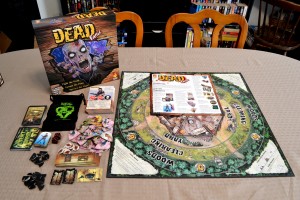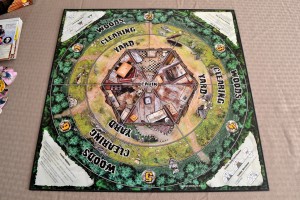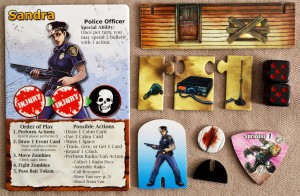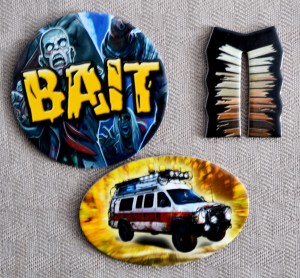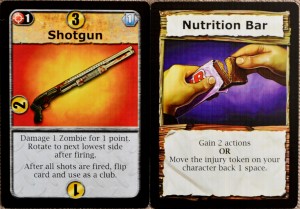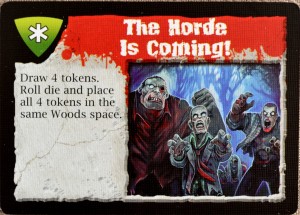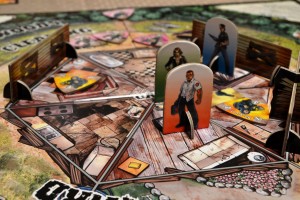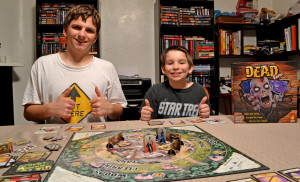I’m going to go on record in the here and now and say that “Castle Panic” is a huge hit in our house. We just love teaming up against hordes of orcs, goblins, and trolls…even if we don’t always succeed. Fireside Games, the maker of the aforementioned game, recently released a new cooperative experience for gamers to sink their teeth into. This time however, players will be doing everything they can not to let the antagonists in this game sink their teeth into them…you guessed it, zombies! The setting? A remote cabin surrounded by acres and acres of trees. Will you and your teammates be able to hold out long enough to assemble the radio pieces and make it out alive? Before we get started, I’d like to thank Justin and Anne-Marie De Witt, the co-owners of Fireside Games, for providing me with a free review copy.
Components
Game Board – The board consists of an area overlay, which is broken up into multiple rings (woods, clearing, yard). A lone cabin sits in the very center of the board.
Cabin & Event Decks – These two decks will serve to either help or endanger the group of survivors, respectively. Cabin cards contain items that players can use to fend off the undead, while event cards trigger the spawning of the undead (among other things).
Character Cards & Stands – There are a total of eight characters in the game, each having their own unique character card and stand. Character cards are double-sided, which allow players to flip them over in the event that they become a zombie.
Tokens, Pieces, & Dice – The game includes a number of different tokens and pieces, along with two six-sided dice. Zombie tokens are triangular in shape and list the hit points in a manner similar to the monster pieces found in “Castle Panic”. A draw bag is included in the box for these pieces in particular. Tokens and pieces include injury tokens that track player damage, cabin walls and crack tokens which tie in with the defense aspect of the game, radio pieces that represent the items players will need to gather in order to win the game, and more.
Setup & Gameplay
Each player will choose a character, take the appropriate character card, and place the corresponding character stand on the cabin. A die roll is used to determine in which arc the characters start. The walls are set up, the event / cabin cards are shuffled separately, and all tokens but the survivors and characters are placed in the bag. Six zombies are drawn (one per arc), and the survivor tokens are then placed into the bag. A die roll also determines who goes first, who in turn receives the bait token.
The game is broken up into rounds, with turns alternating between the players and the undead. Each player will be alloted two action points on a survivor turn, which allows them to attack zombies, draw cabin cards, repair cabin walls, heal injuries, and so on and so forth. It’s worth noting that a player is limited to having a hand size of five cards. Once all of the players have performed their actions, an event card is drawn. Event cards will either spawn new zombies or cause various things to happen, usually to the detriment of the survivors. After the event card is resolved, zombies move & fight, with the bait token being passed to the next player at the end of the turn.
The object of the game is for the survivors to collect all three radio pieces, which will make their way to the cabin via survivor tokens. In the meantime, the undead will be attempting to break down the cabin walls…because well, anytime is breakfast time when you’re a zombie. To stop this from happening, the players will be making use of both ranged and melee weapons in the cabin deck to take down the undead. Once all three radio pieces have been assembled, the rescuer token will spawn in the woods. Players who manage to safely make it to the rescue van, win the game!
The above doesn’t cover all of the rules found in the manual, but should give you an idea as to how the game is played. For more information, please refer to the links listed at the end of this article.
The Review
Being an owner of the game “Castle Panic”, I sort of had an idea as to what to expect in regards to the components. “Castle Panic’s” components were well made, colorful, and full of life. “Dead Panic”, I’m pleased to say, followed suit in that regard. Everything functioned well (for the most part) and the manual did a fairly good job in explaining the rules. This game is a bit more complex than “Castle Panic”, so newcomers should allot themselves some extra time to review the manual. I did take issue with the cardboard stand holders…the holes on some were too large and thus the characters and walls fell out of the holder when picked up. It wasn’t a game breaker, just fairly annoying that both elements weren’t a snug fit.
Firstly, let’s get the obvious question out of the way…”Is ‘Dead Panic’ a ‘Castle Panic’ clone?” In short, no…not even close. It’s true that “Dead Panic” borrows some gameplay elements from “Castle Panic”, like the triangular monster pieces and the fact that the defensible structure is located in the center of the board. There are multiple rings like in “Castle Panic”, giving players a clear indication of how far away the zombies are in relation to the cabin. Players also use cards in both games to dispatch the monsters, however that’s where the similarities end.
For one, players actually have a physical presence on the board. They have a character or group of characters to care about. Players can succumb to the undead and end up working against the other players, making the threat of being overrun all the more intense. Each character also has a special ability, giving players more of an individual role as opposed to being a disposable redshirt. The construction worker, for example, is a great support character as he can repair cracks for free.
Player turns in “Dead Panic” are a bit more uniform in that everyone will be going at the same time…that is, you won’t need to figure out if a monster will reach a particular ring so that you can trade cards and attack it on your turn. “Castle Panic” also had a definitive end in that the monsters you killed stayed dead. Not so in “Dead Panic”…dead zombies are simply placed back into the bag. Finally, and the kids were the first to comment on this, “Dead Panic” is much more complex than “Castle Panic” especially in regards to zombie movement.
This begs another observation…”Is ‘Dead Panic’ a ‘Last Night On Earth’ clone?” Admittedly, there are some similarities between “Last Night On Earth” and “Dead Panic”. Character cards in both games have about two or three injury slots before they “die”, buildings are lootable, and objectives need to be met in order to win the game (getting to the truck / van). “Dead Panic” plays a bit differently however in that you’ll be turtling up in one location…those who try to do that in “Last Night On Earth” usually don’t fare so well. Characters in “Dead Panic” die permanently and convert to the undead, where players in “Last Night On Earth” simply grab a new character and keep playing. The final answer to the above question however still remains to be “no”. Similar, yes…but not a clone.
“Dead Panic”, in the end, turned out to be an engaging and nail-biting experience. Both Vinnie (12) and Anthony (17) enjoyed their time with it and were actively communicating their intentions to the rest of the group. Like “Castle Panic”, teamwork is absolutely essential in order to stand a fighting chance as the game is pretty challenging. Luckily, variants are listed in the manual to make your experience easier or harder, depending on your mood. Gamers who are unable to get along with others or like to be selfish won’t fare well in this game and may even serve to ruin the play experience. The kids and I, being no strangers to cooperative games, really felt a sense of comradery as we fought our uphill battle. At times, it felt like I was playing the episode finale parts of a “Left 4 Dead” campaign…which in my case, is a good thing.
Already own “Castle Panic” and want to know if this game is right for you? That depends. “Castle Panic” is simpler and more family-friendly, making it suitable for younger children. “Dead Panic” has some bloody art…nothing too gory, but it may cause some parents to pause (and rightly so). I highly recommend sticking with the age requirement, though I had no issues with letting Vinnie play. We utilized the “Less Panic” options in the manual to make our play experience a bit more kid-friendly. Profoundly fast-paced and a heck of a lot of fun, “Dead Panic” should be a part of any serious gamer’s collection. This goes double for adult groups who enjoy playing cooperative zombie-themed games like “Last Night On Earth” or “Left 4 Dead”.
Final Verdict: 8/10
—
According to the official website (as of 9/30/13), “Dead Panic” should be available for purchase soon. In the meantime, you can learn more about it by visiting the following websites:
http://www.firesidegames.com/deadpanic.html
http://boardgamegeek.com/boardgame/133437/dead-panic
—

